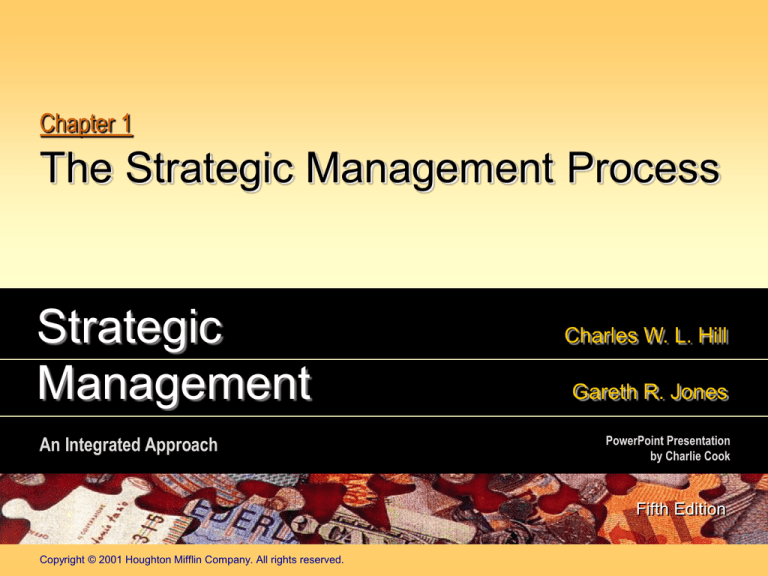
Chapter 1
The Strategic Management Process
Strategic
Management
An Integrated Approach
Charles W. L. Hill
Gareth R. Jones
PowerPoint Presentation
by Charlie Cook
Fifth Edition
Copyright © 2001 Houghton Mifflin Company. All rights reserved.
Overview
Why do some firms succeed while others fail?
A central objective of strategic management is to
learn why this happens.
What is strategy?
An action a company takes to attain superior
performance.
What is the strategic management process?
The process by which managers choose a set of
strategies for the enterprise to pursue its vision.
Copyright © 2001 Houghton Mifflin Company. All rights reserved.
1-2
Strategic Planning
Rational planning by top management?
Basic Strategic Planning Model
Defining the Mission and Setting Top-Level Goals
External Analysis of Opportunities and Threats
Internal Analysis of Strengths and Weaknesses
Selection of Appropriate Strategies
Implementation of Chosen Strategies
Copyright © 2001 Houghton Mifflin Company. All rights reserved.
1-3
The Main
Components of
the Strategic
Planning Process
FIGURE 1.1
Copyright © 2001 Houghton Mifflin Company. All rights reserved.
1-4
Mission and Goals
Mission
Sets out why the organization
exists and what it should be doing.
Major goals
Specify what the organization hopes
to fulfill in the medium to long term.
Secondary goals
Are objectives to be attained that lead to superior
performance.
Copyright © 2001 Houghton Mifflin Company. All rights reserved.
1-5
External Analysis
Identify strategic opportunities and threats in
the operating environment.
Immediate (Industry)
Macroenvironment
Copyright © 2001 Houghton Mifflin Company. All rights reserved.
National
1-6
Internal Analysis
Identify strengths
Quality and quantity of resources available
Distinctive competencies
Identify weaknesses
Inadequate resources
Managerial and
organizational deficiencies
Copyright © 2001 Houghton Mifflin Company. All rights reserved.
1-7
SWOT and Strategic Choice
Strengths and Weaknesses
Opportunities and Threats
(SWOT Analysis)
Strategic Choice
Business
Functional
Global
Corporate
Copyright © 2001 Houghton Mifflin Company. All rights reserved.
1-8
Business-Level Strategies
Cost leadership
Attaining, then using the lowest total cost basis as a
competitive advantage.
Differentiation
Using product features or services to distinguish the
firm’s offerings from its competitors.
Market niche focus
Concentrating competitively on
a specific market segment.
Copyright © 2001 Houghton Mifflin Company. All rights reserved.
1-9
Functional-Level Strategies
Focus is on improving the effectiveness of
operations within a company.
Manufacturing
Marketing
Materials management
Research and development
Human resources
Copyright © 2001 Houghton Mifflin Company. All rights reserved.
1-10
Global-Level Strategies
Multidomestic
International
Global
Transnational
Copyright © 2001 Houghton Mifflin Company. All rights reserved.
1-11
Corporate-Level Strategies
Vertical integration
Diversification
Strategic alliances
Acquisitions
New ventures
Business portfolio
restructuring
Copyright © 2001 Houghton Mifflin Company. All rights reserved.
1-12
Strategy Implementation
Designing organizational structure
Designing control systems
Structure
Market and output controls
Bureaucratic controls
Control through organizational culture
Rewards and incentives
Controls
Matching strategy, structure,
and controls
Congruence (fit) among strategy,
structure, and controls
Copyright © 2001 Houghton Mifflin Company. All rights reserved.
Strategy
1-13
Managing Strategic Change
The only constant is change.
Success requires adapting strategy and
structure to a changing world.
The feedback loop in
Corporate
strategic planning.
Operational
Business
Functional
Copyright © 2001 Houghton Mifflin Company. All rights reserved.
1-14
Strategic Managers
General managers
Responsible for the overall (strategic) performance
and health of the total organization.
Operations managers
Responsible for specific business
functions or operations.
Copyright © 2001 Houghton Mifflin Company. All rights reserved.
1-15
Strategic Managers for All Levels
FIGURE 1.2
Copyright © 2001 Houghton Mifflin Company. All rights reserved.
1-16
Strategic Leadership
Vision, eloquence, and consistency
Commitment to the vision
Being well informed
Willingness to
delegate and empower
Astute use of power
Emotional intelligence
Copyright © 2001 Houghton Mifflin Company. All rights reserved.
1-17
Strategy as an Emergent Process
Strategy making in an unpredictable world
Creates the necessity for flexible strategic approaches.
Strategy making by lower-level managers
Strategy evolves through autonomous action.
Serendipity and strategy
Accidental discoveries and happenstances can have dramatic
effects on strategic direction.
Intended and emergent strategies
Realized strategies are combinations of intended and
emergent strategies.
Copyright © 2001 Houghton Mifflin Company. All rights reserved.
1-18
Intended and Emergent Strategies
FIGURE 1.3
Copyright © 2001 Houghton Mifflin Company. All rights reserved.
Source: Reprinted from “Strategy Formation in an Adhocracy,”
by Henry Mintzberg and Alexandra McGugh, published in
Administrative Science Quarterly, Vol. 30, No. 2, June 1985, by
permission of Administrative Science Quarterly.
1-19
The Strategic Management Process
for Intended and Emergent Strategies
FIGURE 1.4
Copyright © 2001 Houghton Mifflin Company. All rights reserved.
1-20
Strategic Planning in Practice
Planning under uncertainty
Scenario planning for dynamic environmental change
Ivory tower planning
Lack of contact with operational realities
The importance of involving operating managers
Procedural justice in the decision-making process
Engagement, explanation, and expectations
Planning for the present: Strategic Intent
Recognition of the static nature of the strategic fit model
Strategic intent in focusing the organization on winning by
achieving stretch goals
Copyright © 2001 Houghton Mifflin Company. All rights reserved.
1-21
Improving Strategic Decision Making
Cognitive biases systematically influence the
rationality of decision makers.
FIGURE 1.5
Copyright © 2001 Houghton Mifflin Company. All rights reserved.
1-22
Groupthink and Strategic Decisions
Pitfalls of groupthink
Failing to question underlying assumptions.
Coalescing around a single person or policy.
Filtering out conflicting information.
Developing after-the-fact rationalizations.
Having an emotional (nonobjective)
commitment to an action.
Copyright © 2001 Houghton Mifflin Company. All rights reserved.
1-23
Techniques for Improving Decision Making
Two decisionmaking processes
that counteract
cognitive biases
and groupthink.
FIGURE 1.6
Copyright © 2001 Houghton Mifflin Company. All rights reserved.
1-24

